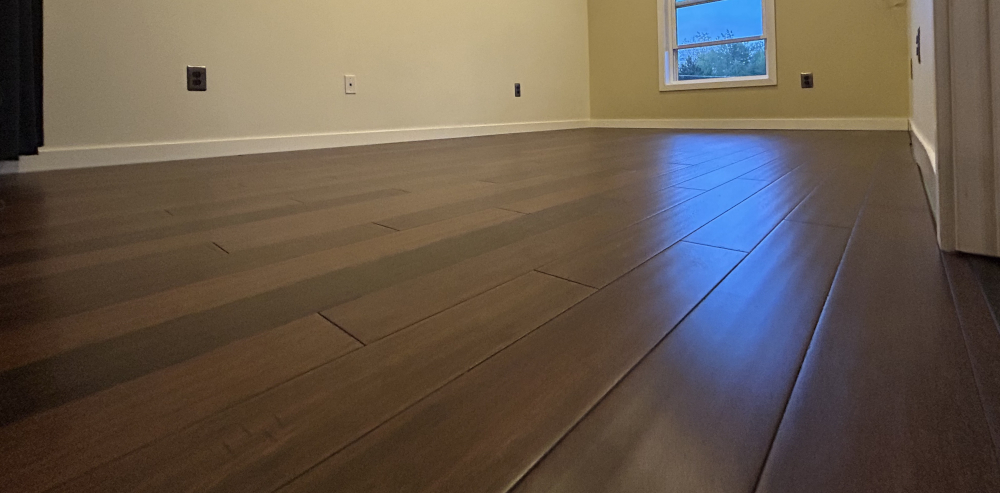A family project offers a break from a normally passive life
Paralyzed with ALS, my husband guides us in laying down a new bedroom floor

Twelve years ago, my husband, Todd, and I installed bamboo flooring in three bedrooms and the living room of our new accessible home. Todd had been diagnosed with ALS two years before, and his arms had become quite weak. Contractors built most of the house, and a few volunteers helped with several things, but Todd thought that he and I could tackle the bamboo floors ourselves.
The bamboo was engineered to click together, and it would float over a thin, foam underlayment. Todd cut the flooring planks with a chop saw, pushing the handle down with assistance from his chin, and coached me in laying down the planks and snapping them together.
We installed carpet tiles in our son’s bedroom, though, and those had been showing the wear from years of an active boy’s life. It was time for an update, and Todd thought our almost 15-year-old son could tackle the job of installing bamboo flooring in his room, with my help as needed. Todd, who’s paralyzed, can’t help physically, but he could coach us.
I found a flooring supplier, our son picked the color, and Todd figured out how many boxes of planks we needed to order. I picked up some other supplies, including new saw blades and transition strips.
The new floor project
Last Saturday, I got Todd out of bed, and after feeding him breakfast, we started the project. Todd had our son sort the boards by shade and patterns of distress marks, and they made a plan to draw from the different piles so they wouldn’t end up with sections of the floor with groupings of too-similar boards.
Once we moved out the furniture and took out the carpeting, we could see that the walls needed a fresh coat of paint. It’d be easier to paint without needing to lay down a drop cloth, so we touched up the walls before we started on the flooring.
We then put down the foam underlayment. When we got to the last row, I was preparing to cut along the length of the last piece with scissors, but Todd suggested we lay it down with one edge riding up the wall, then use a utility knife to cut the foam along the baseboard.
Afterward, our son laid down the first row of boards, and Todd instructed him to flip the last board around and make a mark for where to cut, rather than using a tape measure. After he cut the first plank with a chop saw, I told our son how his dad used his chin to cut the flooring we’d laid in the other rooms.
The project went smoothly, and it was fun to see the guys so engrossed in the job that they didn’t want to stop for lunch. Todd just had me feed him beef jerky, and our son grabbed a few pieces as he was passing through the kitchen on his way to the garage to cut boards.
I don’t think I did much caregiving that day. Perhaps Todd was so engaged in what was happening that he didn’t feel his usual discomforts, and he didn’t ask for many adjustments to his arms or noninvasive ventilator mask. Or maybe I was so focused on the room’s progress that I don’t remember the help I gave him.
I don’t know when we last spent so much time together. Now that Todd is homebound, we don’t go out for vacations or activities. We have family movie nights and sometimes play games, but we don’t typically spend an entire day together.
Todd said it wasn’t too taxing because he actually didn’t talk a lot, but we were glad he was there to coach us when needed. And for Todd, the project was a nice change from his typically passive life of watching YouTube videos.
It was good to create something tangible, and the floor looks beautiful.

Our new flooring. (Photo by Kristin Neva)
Note: ALS News Today is strictly a news and information website about the disease. It does not provide medical advice, diagnosis, or treatment. This content is not intended to be a substitute for professional medical advice, diagnosis, or treatment. Always seek the advice of your physician or other qualified health provider with any questions you may have regarding a medical condition. Never disregard professional medical advice or delay in seeking it because of something you have read on this website. The opinions expressed in this column are not those of ALS News Today or its parent company, Bionews, and are intended to spark discussion about issues pertaining to ALS.








Leave a comment
Fill in the required fields to post. Your email address will not be published.